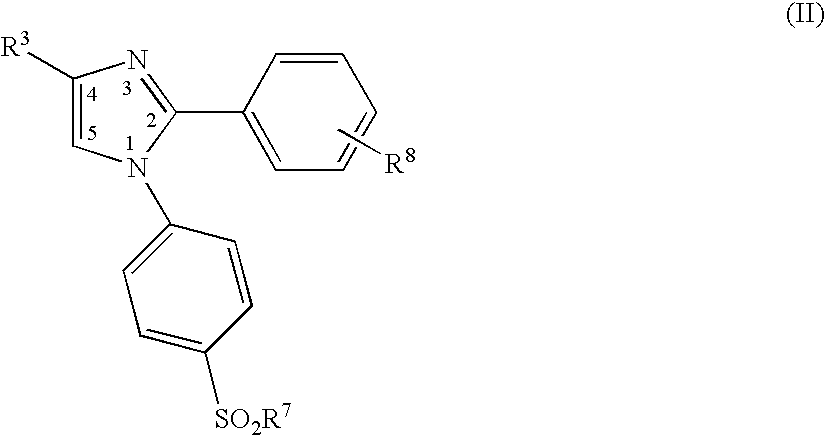Heterocyclo-substituted imidazoles for the treatment of inflammation
a technology of heterocyclic compound and imidazole, which is applied in the field of antiinflammatory pharmaceutical agents, can solve the problems of limiting the therapeutic potential of heterocyclic compound and more drastic side effects
- Summary
- Abstract
- Description
- Claims
- Application Information
AI Technical Summary
Benefits of technology
Problems solved by technology
Method used
Image
Examples
example 1
[0859]
2-(4-Chlorophenyl)-4-hydroxy-1-[4-(methylsulfonyl)phenyl]-4-(trifluoromethyl)-4,5-dihydro-1H-imidazole
Step 1: Preparation of 4-chloro-N-[4-(methylsulfonyl)phenyl]benzenecarboximidamide
[0860]To a suspension of 4-(methylsulfonyl)aniline (7 g, 41 mmol) in toluene (400 mL), trimethylaluminum (2M solution in toluene, 30.5 mL, 61 mmol) was added over 15 minutes. The reaction mixture was warmed to room temperature and stirred for 2.5 hours. A solution of 4-chlorobenzonitrile (11.3 g, 82 mmol) in toluene (200 mL) was added over 10 minutes and the reaction mixture was heated to 80–85° C. After 16 hours, the reaction mixture was cooled to room temperature and poured over a slurry of silica gel in chloroform. After filtration, the residue was washed with a mixture of methylene chloride / methanol. The combined filtrates were concentrated in vacuo and the resulting yellowish solid was stirred with a mixture of hexane / ether (2 / 1, 1000 mL). The intermediate was filtered and washed with more o...
example 2
[0862]
2-(4-Chlorophenyl)-1-[4-(methylsulfonyl)phenyl]-4-(trifluoromethyl)-1H-imidazole
[0863]A mixture of 2-(4-chlorophenyl)-4-hydroxy-1-[4-(methylsulfonyl)phenyl]-4-(trifluoromethyl)-4,5-dihydro-1H-imidazole from Example 1 (6.2 g, 15.4 mmol) and p-toluenesulfonic acid monohydrate (0.9 g, 4.7 mmol) in toluene (300 mL) was heated to reflux for 84 hours. The reaction mixture was cooled and the solvent removed under reduced pressure. The crude residue was redissolved in methylene chloride and washed with water, aqueous sodium bicarbonate and brine. After drying (Na2SO4), filtration and concentrating in vacuo, the crude mixture was purified by chromatography on silica gel using hexane / ethyl acetate (1 / 1) to give pure 2-(4-chlorophenyl)-1-[4-(methylsulfonyl)phenyl]-4-(trifluoromethyl)-1H-imidazole (4.21 g, 71%) as a white solid: mp (DSC) 183° C. Anal. Calc'd. for C17H12N2SO2F3Cl: C, 50.94; H, 3.02; N, 6.99. Found: C, 50.64; H, 3.03; N, 6.85.
example 3
[0864]
1-(4-Fluorophenyl)-4-hydroxy-2-[4-(methyloulfonyl)phenyl]-4-(trifluoromethyl)-4,5-dihydro-1H-imidazole
Step 1: Preparation of 4-methylsulfonyl-N-[4-chlorophenyl]benzenecarboximidamide
[0865]To a suspension of 4-fluoroaniline (4 mL, 40 mmol) in toluene (120 mL), trimethylaluminum (2M solution in toluene, 21 mL, 42 mmol) was added over 15 minutes. The reaction mixture was warmed to room temperature and stirred for 3 hours. A solution of 4-(methylsulfonyl)benzonitrile (7.65 g, 40 mmol) in methylene chloride (100 mL) was added over 10 minutes and the reaction mixture was heated to 70–75° C. After 48 hours, the reaction mixture was cooled to room temperature and poured over a slurry of silica gel in chloroform. After filtration, the residue was washed with a mixture of methylene chloride / methanol. The combined filtrates were concentrated in vacuo and the resulting crude intermediate (7.7 g) was purified by chromatography [silica gel, hexane / ethyl acetate, 25 / 75] to give 4-methylsulfo...
PUM
 Login to View More
Login to View More Abstract
Description
Claims
Application Information
 Login to View More
Login to View More - R&D Engineer
- R&D Manager
- IP Professional
- Industry Leading Data Capabilities
- Powerful AI technology
- Patent DNA Extraction
Browse by: Latest US Patents, China's latest patents, Technical Efficacy Thesaurus, Application Domain, Technology Topic, Popular Technical Reports.
© 2024 PatSnap. All rights reserved.Legal|Privacy policy|Modern Slavery Act Transparency Statement|Sitemap|About US| Contact US: help@patsnap.com










